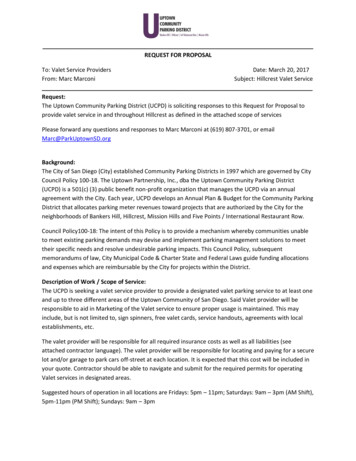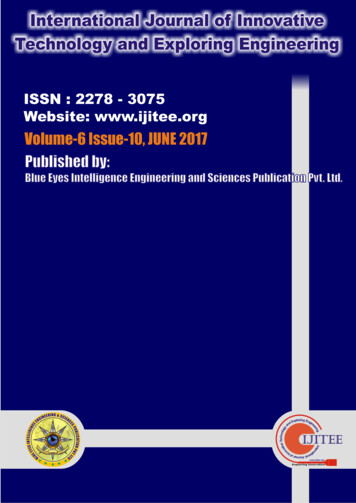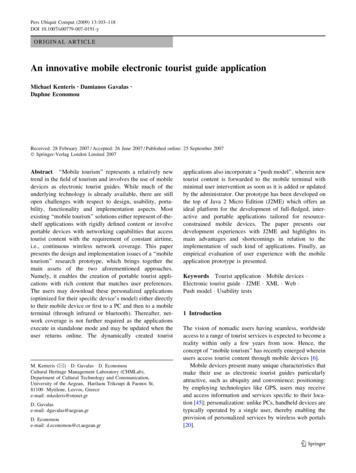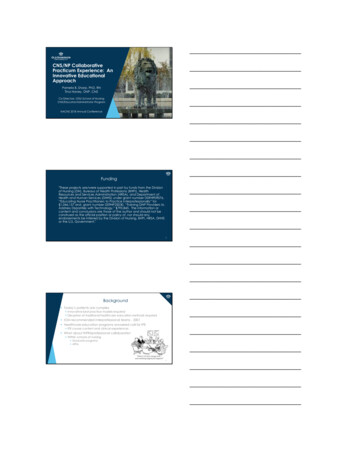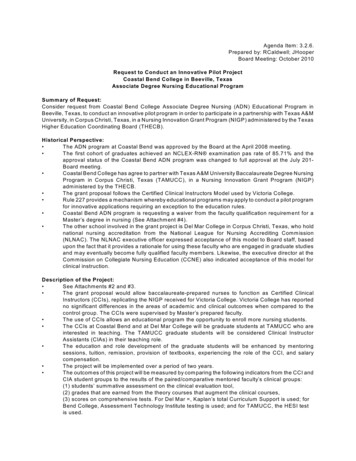
Transcription
Agenda Item : 3.2.6.Prepared by: RCaldwell; JHooperBoard Meeting: October 2010Request to Conduct an Innovative Pilot ProjectCoastal Bend College in Beeville, TexasAssociate Degree Nursing Educational ProgramSummary of Request:Consider request from Coastal Bend College Associate Degree Nursing (ADN) Educational Program inBeeville, Texas, to conduct an innovative pilot program in order to participate in a partnership with Texas A&MUniversity, in Corpus Christi, Texas, in a Nursing Innovation Grant Program (NIGP) adm inistered by the TexasHigher Education Coordinating Board (THECB).Historical Perspective: The ADN program at Coastal Bend was approved by the Board at the April 2008 m eeting. The first cohort of graduates achieved an NCLEX-RN exam ination pas rate of 85.71% and theapproval status of the Coastal Bend ADN program was changed to full approval at the July 201Board m eeting. Coastal Bend College has agree to partner with Texas A&M University Baccalaureate Degree NursingProgram in Corpus Christi, Texas (TAMUCC), in a Nursing Innovation Grant Program (NIGP)adm inistered by the THECB. The grant proposal follows the Certified Clinical Instructors Model used by Victoria College. Rule 227 provides a m echanism whereby educational program s m ay apply to conduct a pilot programfor innovative applications requiring an exception to the education rules. Coastal Bend ADN program is requesting a waiver from the faculty qualification requirem ent for aMaster’s degree in nursing (See Attachm ent #4). The other school involved in the grant project is Del Mar College in Corpus Christi, Texas, who holdnational nursing accreditation from the National League for Nursing Accrediting Com m ission(NLNAC). The NLNAC executive officer expressed acceptance of this m odel to Board staff, basedupon the fact that it provides a rationale for using these faculty who are engaged in graduate studiesand m ay eventually becom e fully qualified faculty m em bers. Likewise, the executive director at theCom m ission on Collegiate Nursing Education (CCNE) also indicated acceptance of this m odel forclinical instruction.Description of the Project: See Attachm ents #2 and #3. The grant proposal would allow baccalaureate-prepared nurses to function as Certified ClinicalInstructors (CCIs), replicating the NIGP received for Victoria College. Victoria College has reportedno significant differences in the areas of academ ic and clinical outcom es when com pared to thecontrol group. The CCIs were supervised by Master’s prepared faculty. The use of CCIs allows an educational program the opportunity to enroll m ore nursing students. The CCIs at Coastal Bend and at Del Mar College will be graduate students at TAMUCC who areinterested in teaching. The TAMUCC graduate students will be considered Clinical InstructorAssistants (CIAs) in their teaching role. The education and role developm ent of the graduate students will be enhanced by m entoringsessions, tuition, rem ission, provision of textbooks, experiencing the role of the CCI, and salarycom pensation. The project will be im plem ented over a period of two years. The outcom es of this project will be m easured by com paring the following indicators from the CCI andCIA student groups to the results of the paired/com parative m entored faculty’s clinical groups:(1) students’ sum m ative assessm ent on the clinical evaluation tool,(2) grades that are earned from the theory courses that augm ent the clinical courses,(3) scores on com prehensive tests. For Del Mar , Kaplan’s total Curriculum Support is used; forBend College, Assessm ent Technology Institute testing is used; and for TAMUCC, the HESI testis used.
Pros: Cons: (4) scores for the NCLEX-RN pass rates for Del Mar College, Coastal Bend College, and forTAMUCC, and(5) retention rates for clinical experiences for the past two years will be com pared to the retentionrates for the clinical groups with the CIAs.Mechanism s are in place to assist any students who m ay experience negative effects. The CCIs willhave a faculty m entor readily available to assist with problem resolution. During this first phase, facultywill retain ultim ate responsibility for the students.This m odel was successfully im plem ented by Victoria College in Victoria, Texas.The m odel provides a m echanism for program s to “grow their own” faculty.THECB has awarded funding for this project and has encouraged nursing program s to use thism odel.Though the data at Victoria College supported the concept, the m odel has not been widely tested.It m ay not be possible for program s to continue the m odel without ongoing funding.Staff Recommendation:Move to approve Coastal Bend College’s request to conduct an innovative pilot project allowing a waiver forfaculty qualification requirem ents allowing their participation in the Nursing Innovation Grant Programadm inistered by the Texas Higher Education Coordinating Board and issue the requirem ent as indicated inthe attached letter (Attachm ent #3).
Agenda Item: 3.2.6.Attachment #1Texas A&M University, Corpus ChristiCollege of Nursing and Health SciencesNursing Innovation Grant ProgramBest Practices Pre-proposalDue Monday, March 15, 2010Project Title: TAMUCC Best Practices Preparing Certified Clinical InstructorsApplicant Organization: Texas A&M University, Corpus Christi (TAMUCC),College of Nursing and Health Sciences (CONHS)Project Director: Mary D. Bantell EdD, RN, Associate ProfessorAddress: 6300 Ocean Drive, Unit 5805 Corpus Christi, TX 78412-5805Contact Phone Numbers: 361-825-5939 / Fax 361-825-5853Email Address: Mary.Bantell@tamucc.eduOrganizational Website: www.tamucc.eduIntroduction/CollaborationThe Best Practices Grants Competition, Best Practices #3: Preparing Certified Clinical Instructors will bereplicated. TAMUCC will form partnerships with Del Mar College and Coastal Bend Community Collegeto implement this program. Dr. Bertha Almendarez, Nursing Chair, Del Mar College and Ms. Betty Sims,Director of Nursing Education for Coastal Bend College have agreed to collaborate on this grant.TAMUCC has the administrative and managerial resources and capacity to implement the proposed programas described in this proposal. Established in 1947, TAMUCC is part of the Texas A&M University System,a network of nine universities, seven state agencies and a comprehensive health science center. Designateda Hispanic-Serving Institution with a budget of 11 million, TAMUCC is a four-year university with anenrollment of 9,100 students representing forty-eight states and sixty-seven foreign countries. More thanseventy percent of students receive some form of financial assistance. The university offers Bachelor’s,master's and doctoral degrees in five colleges including Business, Education, Liberal Arts, Nursing & HealthSciences and Science Technology. TAMUCC has a long history of working with and administering grantfunded programs that benefit underserved, disadvantaged and/or minority students. Our partner organizations,Del Mar College and Coastal Bend College, are also well established, accredited colleges accustomed toworking with the target population.GOALSThe goals of this grant are consistent with the Nursing Innovation Grant Program: Best Practices 3:Preparing Certified Clinical Instructors, in that the purposes of this proposal are to:
······increase the number of initial RN licensure nursing students in Associate Degree Programs by preparingCertified Clinical Instructors to teach in undergraduate clinical areas at Del Mar College and Costal BendCollege;increase the retention of initial RN licensure students in the undergraduate Baccalaureate Program atTAMUCC by preparing Clinical Instructor Assistants to augment the workload of clinical faculty,thereby freeing-up time for clinical faculty to work more closely with at-risk students; andsupport the education and role development of graduate students who express an interest in pursuing afaculty role through a graduate student mentoring program by providing: structured mentoring sessions for graduated students; mentoring with identified expert clinical faculty; tuition remission of graduate education courses, and course textbooks; experiential experience in the role as either a Certified Clinical Instructor or a ClinicalInstructor Assistant, and; salary compensation.STRATEGIESThe strategies for implementing this program include indentifying:a Program Coordinator who would be responsible for coordinating, planning, implementing of theprogram in general and who would be responsible for planning and implementing the mentoring sessionswith the graduate students;masters prepared faculty to act as mentors for both the Certified Clinical Instructors and ClinicalInstructor Assistants to the graduate students by Costal Bend Community College, Del Mar College andTAMUCC;graduate students enrolled in the Graduate Program at TAMUCC who are interested in teaching.The Chairs/Directors of the nursing programs or their designees will identify Masters preparedclinical faculty to act as the clinical faculty mentors/support persons. It is estimated that six graduatestudents will be identified in TAMUCC’s Graduate Program. The criteria for graduate students tobe eligible to participate in this program are: an unencumbered RN Texas License, BS in nursing,three years of recent clinical experience, enrolled in TAMUCC Graduate Program, complete 7 credithours of nursing education graduate courses; Nursing 5353 Nursing Theories, a 3 credit hour courseand Nursing 5459 Practicum in Nursing Education a 4 credit course, and attend mentoring sessions.The National League for Nursing (NLN) The Mentoring of Faculty Tool Kit has been identified asthe framework for the sessions rces.htmOUTCOMESAs identified in the Best Practices 3 Grant Preparing Certified Clinical Instructors, the number ofinitial RN licensure nursing students who graduated and successfully sat for the NCLEX increasedby preparing clinical faculty to teach a full complement of students in the clinical area.The outcomes of this program are similar to the Best Practices 3 Grant: Preparing Certified ClinicalInstructors in that the program is projected to:1. Provide education and support for the Certified Clinical Instructors and the Clinical InstructorAssistants to facilitate safe and quality patient care in the clinical areas;2. Provide a quality education and mentoring support to the Certified Clinical Instructors and theClinical Instructor Assistants based on recognized national standards;3. Increase the number of initial RN licensure nursing students for each of the nursing programs by
identifying, supporting, and preparing graduate students to assume the roles as Certified ClinicalInstructors for Del Mar College and Costal Bend College, and Clinical Instructor Assistances forTAMUCC;4. In addition, as identified as an added benefit in the Best Practices 3 Grant, some of the CertifiedClinical Instructors continued to pursue their MSN education. It is anticipated that some of thegraduate students participating in this program will also complete their MSN degrees and continueto pursue a career as nurse educators. The additional mentoring process integrated into this proposalmay provide the added support and mentoring of graduate students who are interested in pursuinga career as a nurse educator, thereby increasing the likelihood of continuing in a career path as anurse educator.ESTIMATED COST OF THE PROJECT 299, 986.00
Agenda Item: 3.2.6.Attachment # 2NursingInnovationGrant ProgramProjectDescriptionProject #Institution and Project Title:Texas A&M University, Corpus Christi (TAMUCC),College of Nursing and Health Sciences (CONHS)TAMUCC Best Practices Preparing Certified Clinical InstructorsBriefly describe the problem that TAMUCC Best Practice Project is designedto address TAMUCC’s Certified Clinical Instructor and Clinical InstructorAssistant Project (TAMUCC Best Practices) is designed to increase the numberof initial RN licensure students graduating from three programs by addressing theproblem of a shortage of clinical nursing faculty. Nursing programs are limited asto the number of students that they can admit to their programs if they do not haveadequate numbers of faculty to teach both didactic and clinical components.Large numbers of students can adequately receive a quality education in thedidactic component with a limited number of faculty, however, it is mandated bythe Texas Board of Nurse Examiners (2009) that the clinical component remainwith a smaller faculty to student ratio of 1:10. (Rule 215.10, Clinical LearningExperiences, paragraph 1).In the American Association of Colleges' (AACN, 2009) most recent report onfaculty shortages, it was noted that almost 50,000 qualified applicants were notadmitted to undergraduate or graduate nursing programs. Insufficient number offaculty was cited as one of the primary reasons schools turned-away students.Nursing programs that do not have adequate numbers of faculty to teach the clinicalcomponents of their curriculum must limit the number of students that they admit,thereby limiting the number of initial RN licensure students they graduate.This TAMUCC Best Practice Project is designed to increase the number of facultyto teach as Certified Clinical Instructors (CCIs) for Del Mar College and CoastalBend College thereby increasing the total number of initial RN students graduatingfrom both programs. The project will also support the role of Clinical InstructorAssistant (CIA) to reduce the workload of the teaching responsibilities of clinicalfaculty at TAMUCC to free-up time for the clinical faculty to work more closelywith at-risk students, thereby increasing the retention rate of the student populationand increasing the initial RN licensure students graduating from TAMUCC.Describe the previous best practice that supports the proposed projectThe Best Practice 3: Preparing Certified Clinical Instructors, implemented byVictoria College (VC) is the general framework used for the project. The BestPractice 3 project created an innovative educational path to offer graduate nursing
education courses, and to identify clinical practice requirements ofbaccalaureate-prepared nurses to prepare the nurses to work in the role as a CCI.They were paired with a more experienced faculty to act as a mentor. The resultsof the Best Practices 3 project suggest that the CCIs provided a clinical educationto pre-licensure RN students in the clinical area that was comparable to the clinicaleducation provided by the MSN clinical instructors based on identified criteria.In Victoria College’s January 2009 Status Report of the Nursing Innovation Grant,it was reported that there were no differences in comparing course grades, clinicalperformance, and the Assessment Technologies Institute score results between thestudents in the CCI groups and the students who were assigned in the MSN clinicalinstructor group. It was also noted that all four of the CCIs continued to pursue theirMSN degree and that student evaluations of the CCIs were favorable.The final evaluation of the Best Practice 3 project reiterates the formative resultsof the project and reported that 100% of the students in the CCIs clinical grouppassed their NCLEX-RN examination on their first attempt. As a result ofimplementing this project an additional twenty-eight students graduated.The TAMUCC Best Practices project will mirror the essence of the Best Practice3 project with three modifications. The modifications to this project are based onthe different levels of education offered at TAMUCC and the accreditationrequirements of TAMUCC; Victoria College is an Associate Degree Nursing(ADN) program and TAMUCC is a baccalaureate and graduate degree-grantinginstitution. TAMUCC is accredited by the Commission on Collegiate NursingEducation (CCNE) and Victoria College is accredited by the National League forNursing Accrediting Commission (NLNAC).The differences in the grant-seeking institutions [Victoria College andTAMUCC] resulted in the modifications to the original Best Practice 3 andinclude:1) adding an additional title and role for the baccalaureate prepared nurse as theClinical Instructor Assistant (CIA) for TAMUCC. The rationale for creating thisposition was to work within the accreditation requirements of CCNE to have onlymaster’s prepared faculty to work autonomously with students, and to meet theprogram goal to increase the retention of students2) collaborating with partners in our local ADN programs (Del Mar College andCoastal Bend College) as opposed to collaborating with clinical/hospital-basedpartners. In the Best Practice 3 project, the pool of baccalaureate prepared RNswere identified by the hospital partners. Since TAMUCC also offers graduatedegrees, there is a pool of students that have expressed an interest in pursuing acareer path in nursing education. The primary barriers to the graduate studentseither working as TAs or taking additional nursing education courses have beenrelated to the low salaries for TAs [they could make more money in their currentRN position], and the added cost of the education courses.3) integrating a mentoring program to provide consistent support throughout theproject cycle. It is documented that nursing faculty beginning their careers aremore likely to remain in their teaching positions and are better satisfied with theircareer choice when they have been mentored. According to Dunham-Taylor et al.“Mentorship is the single most influential way to successfully develop new nursing
faculty, reaping the benefits of recruitment, retention, and long-term maturation offuture nurse mentors” (2008, p. 337). This project has integrated structuredface-to-face mentoring sessions to be scheduled at two intervals during the teachingsemesters. The face-to face mentoring sessions will be augmented by utilizingdistance education technology. A course shell will be developed within TAMUCC’sBlackboard distance education course delivery system to provide formal andinformal mentoring support and information to the CCI and CIA faculty. TheProject Director Dr. Mary Bantell has been identified to facilitate the mentoringsessions. The National League for Nursing's (NLN) publication The Mentoring ofFaculty Tool Kit (2006) has been identified as the framework for the sessions.The criteria for the baccalaureate prepared nurses in this project also includes:1) an unencumbered RN Texas license, 2) three years of recent clinical experiencewithin the past five years, 3) successful completion of two nursing educationgraduate courses; Nursing 5353 and Nursing 5459. Taken in the fall semester atTAMUCC through the graduate program, the courses are taught by doctoralprepared faculty. Nursing 5353, Theory and Concepts for the Nurse Educator(Appendix A), a three credit hour course focuses on the scientific and theoreticalfoundations of nursing education.Nursing 5459, Education Practicum for the Nurse Educator (Appendix B), is a fourcredit hour course that applies the roles of the nurse educator by using the nurseeducator competencies as a framework for the practicum experience. The totalnumber of 7 credit hours of coursework in nursing education, and 4) compliancewith the faculty requirements [as set forth by the clinical agency] for teaching in theclinical areas, i.e. immunizations, in-services.Estimate the number of people affected by the projectThe TAMUCC Best Practice project will prepare a total of seven instructors (4certified clinical Instructors (CCIs,) 2 to work at Del Mar College, 2 to work atCoastal Bend College and 3 Clinical Instructor Assistants (CIAs) to work atTAMUCC). While this project does replicate the Best Practice 3 project in thatCCIs are identified to teach clinical courses in the ADN programs, the project wasrequired to differentiate TAMUCC based on the baccalaureate level of
Oct 03, 2010 · This model was successfully implemented by Victoria College in Victoria, Texas. The model provides a mechanism for programs to “grow their own” faculty. THECB has awarded funding for this project and has encouraged nursing programs to use this model. Cons:
